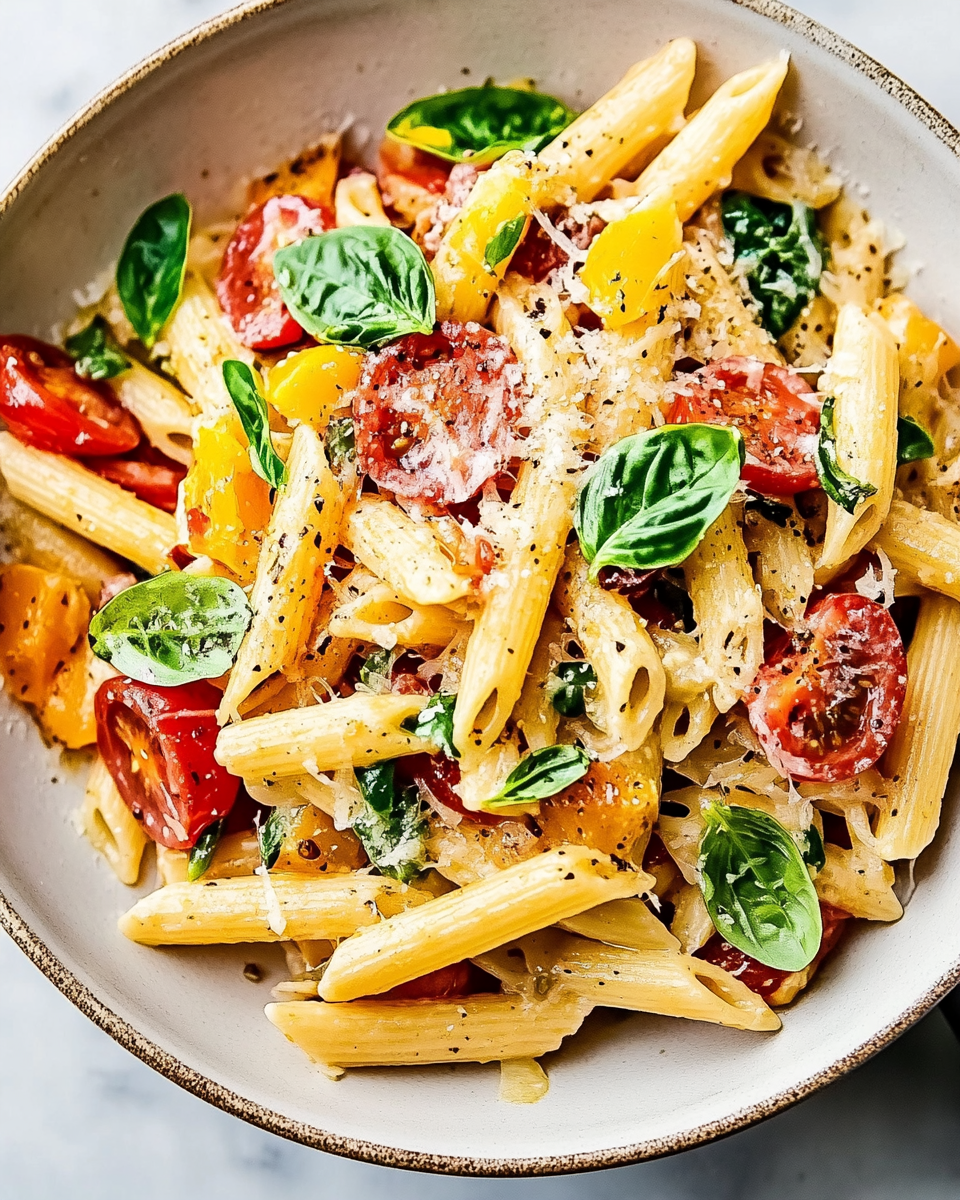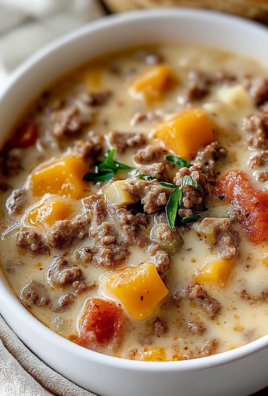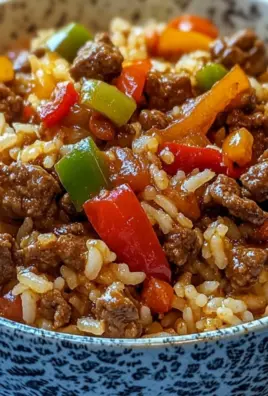Pasta Primavera is a light yet satisfying Italian-American pasta dish traditionally made with fresh spring vegetables and a delicate cream or butter-based sauce. The name Primavera means “spring” in Italian, highlighting the seasonal freshness of the ingredients. This dish brings together sautéed vegetables like zucchini, squash, carrots, and tomatoes tossed with tender pasta and coated in a creamy, cheesy sauce.

While it originated in the 1970s, its timeless appeal lies in its balance of comfort and brightness. Unlike heavy cream-based pasta dishes, Pasta Primavera feels fresh, vibrant, and full of texture—making it a favorite during warmer months but enjoyable year-round.
Why You’ll Love This Pasta Primavera
There are many reasons this creamy vegetable pasta should be part of your weeknight rotation:
- It’s vegetarian and full of wholesome ingredients
- Packs a variety of vegetables into one satisfying meal
- Comes together in under 40 minutes
- Offers plenty of room for customization
- Perfect as a light lunch, dinner, or meatless main course
Whether you’re looking for a healthy comfort food option or just want to use up fresh seasonal produce, Pasta Primavera delivers both flavor and flexibility.
Tools You’ll Need
To make this recipe as smooth and enjoyable as the dish itself, use the following kitchen tools:
- Large pot: For boiling pasta.
- Large skillet or sauté pan: To sauté vegetables and combine everything.
- Chef’s knife: For precise and even chopping.
- Cutting board: Preferably wood or plastic.
- Measuring spoons and cups: To ensure proper ratios for the sauce.
- Tongs or pasta fork: For tossing the pasta with the sauce.
Why These Tools Matter
Using a large enough pot prevents pasta from sticking. A skillet with enough surface area helps caramelize the vegetables evenly. Tongs allow you to gently mix everything without breaking the pasta or vegetables.
Preparation Tips
- Prep all vegetables before starting to cook. This streamlines the process and avoids overcooking.
- Slice vegetables into similar sizes to ensure even cooking.
- Freshly grate Parmesan cheese for optimal flavor and meltability.
- Don’t overcook the pasta—al dente is key.
- Sauté vegetables in batches to avoid overcrowding the pan.
Ingredients Breakdown
Here’s what you’ll need to make this creamy, comforting vegetarian pasta dish:
Pasta & Vegetables
- 12 oz pasta (penne or bucatini recommended)
- 1 large carrot, cut into matchsticks
- 1 medium zucchini, halved and sliced
- 1 medium yellow squash, halved and sliced
- 1½ cups cherry tomatoes, halved
- ⅓ cup sun-dried tomatoes, chopped
- 1 large shallot, thinly sliced
Sauce & Seasonings
- 6 tablespoons unsalted butter, cut into pieces
- ¾ cup freshly grated Parmesan cheese, plus extra for serving
- ½ cup whole milk, plus more as needed
- 1 teaspoon dried basil
- ½ teaspoon garlic powder
- ½ teaspoon sea salt
- ½ teaspoon freshly cracked black pepper
For Serving (Optional)
- Chopped fresh basil or flat-leaf parsley
- Crushed red pepper flakes for heat
Step-by-Step Directions
1. Cook the Pasta
Bring a large pot of salted water to a boil. Cook pasta according to package instructions until al dente. Drain and set aside.
2. Sauté the Vegetables
Heat 1 tablespoon olive oil in a large skillet over medium-high heat. Add shallot and carrot. Cook for 5 minutes, stirring occasionally, until softened. Transfer to a plate.
Add the remaining tablespoon of olive oil. Place zucchini and squash in a single layer in the skillet. Cook for about 3 minutes per side until golden and tender. Transfer to the plate with carrots and shallot.
3. Make the Sauce
In the same skillet, melt the butter. Whisk in the Parmesan cheese, milk, dried basil, garlic powder, salt, and pepper. Stir until the sauce is smooth and well combined.
4. Add Tomatoes
Stir in sun-dried tomatoes and cherry tomatoes. Cook for 1–2 minutes until just warmed through. Remove the pan from heat.
5. Combine and Toss
Return cooked pasta and sautéed vegetables to the skillet. Toss gently until all ingredients are evenly coated in the creamy sauce.
6. Serve
Serve hot, topped with extra Parmesan, fresh herbs, and a sprinkle of crushed red pepper flakes if desired.
Pro Tip:
If the sauce thickens too much, stir in a splash of warm milk. If it’s too thin, add a bit more Parmesan.
Best Ways to Serve Pasta Primavera
This creamy vegetable pasta is best enjoyed fresh and warm. The combination of sautéed vegetables and silky Parmesan sauce shines most when served immediately after preparation. However, there are a few ways to elevate the serving experience:
- Serve in shallow bowls to showcase the colorful vegetables and allow for even heat distribution.
- Top generously with freshly grated Parmesan for added richness and depth.
- Sprinkle with chopped fresh basil or parsley to enhance the freshness and bring out the natural sweetness of the vegetables.
- Add crushed red pepper flakes if you enjoy a little heat.
- Drizzle with a touch of extra-virgin olive oil right before serving for a silky finish.
For meal prep, Pasta Primavera can be made in advance and stored for a few days. If you plan to serve it later, consider undercooking the vegetables slightly during the initial sauté. This prevents them from becoming too soft when reheated.
Common Mistakes to Avoid
Though this dish is fairly simple, there are a few pitfalls that can affect its flavor and texture. Here are the most common mistakes and how to avoid them:
1. Overcooking the Pasta
Cooking pasta until mushy can ruin the balance of textures. Always cook until al dente and rinse briefly under warm water if it’s ready before the sauce.
2. Overcrowding the Pan
When sautéing vegetables, crowding the pan can lead to steaming instead of browning. Cook in batches if needed to allow the vegetables to caramelize properly and retain some bite.
3. Skipping Seasoning Layers
Season each component—especially the vegetables—lightly with salt and pepper as they cook. Relying on the final sauce alone can result in a bland dish.
4. Using Pre-Shredded Parmesan
Pre-grated cheeses often contain anti-caking agents that prevent smooth melting. For the best texture and flavor, always grate your Parmesan fresh.
5. Letting the Sauce Sit Too Long
The butter and milk-based sauce may thicken quickly. If it sits too long before combining with pasta, it can become too thick. Always mix the pasta and vegetables into the sauce while it’s still warm and fluid.
6. Not Adjusting the Sauce
Depending on your pasta shape and the absorption rate, the sauce may need adjustments. Add a splash of warm milk if it seems too thick or more cheese if it feels too thin.
Recommended Side Dishes
Pasta Primavera stands well on its own, but pairing it with complementary sides can round out the meal beautifully. Here are eight side dish ideas that match its flavor profile and elevate your table:
1. Garlic Bread
A classic and indulgent side. Crisp, buttery garlic bread offers a perfect contrast to the creamy pasta and helps soak up every bit of sauce.
2. Arugula Salad with Lemon Vinaigrette
The peppery bite of arugula and the acidity of lemon dressing cut through the richness of the dish, offering balance and freshness.
3. Roasted Asparagus
Asparagus brings a touch of bitterness and a charred flavor that complements the sweetness of the cherry tomatoes and carrots in the pasta.
4. Caprese Salad
Tomatoes, fresh mozzarella, and basil dressed with olive oil and balsamic glaze make a bright, refreshing side that mirrors the Italian-inspired ingredients in Pasta Primavera.
5. Crispy Roasted Chickpeas
These add protein, crunch, and a savory flavor that contrasts the creaminess of the pasta while keeping the meal vegetarian.
6. Creamy Tomato Basil Soup
Pairing two creamy dishes may seem bold, but a lighter tomato-based soup provides a rich but tangy companion, especially in cooler months.
7. Grilled Artichokes
These bring a smoky, earthy flavor and pair especially well with the buttery Parmesan sauce in the pasta.
8. Lemon-Parmesan Green Beans
Green beans sautéed with garlic, lemon zest, and Parmesan echo the brightness and texture of the pasta while offering a bit more snap.
Expert Tips for Perfect Pasta Primavera
Even though this dish is simple, a few expert-level tweaks can elevate it from good to great.
Use Seasonal Vegetables
The more seasonal and fresh your vegetables, the better the flavor. In spring and summer, opt for zucchini, squash, asparagus, and cherry tomatoes. In fall, try broccoli, bell peppers, or mushrooms.
Try Different Pasta Shapes
While penne and bucatini are traditional choices, you can also use farfalle, fusilli, or orecchiette. Just make sure to adjust the cooking time and check for al dente texture.
Make It Vegan
Swap out the butter for a plant-based version, use unsweetened almond or oat milk, and replace Parmesan with a vegan cheese alternative or nutritional yeast. The result is still creamy and flavorful, but dairy-free.
Add Protein
To turn this into a heartier main course, add:
- Grilled chicken breast
- Sautéed shrimp
- Crispy tofu or chickpeas
- White beans
These options maintain the light feel of the dish while making it more filling.
Brighten It Up
A squeeze of lemon juice or a small amount of lemon zest added just before serving can enhance the overall freshness and bring balance to the creamy sauce.
Storage and Reheating
Pasta Primavera stores well for short periods, making it suitable for meal prep or leftovers. However, for the best taste and texture, keep the following tips in mind.
Storage Guidelines
- Allow pasta to cool completely before storing.
- Place in an airtight container and refrigerate for up to 3 to 4 days.
- Do not freeze, as the creamy sauce and vegetables may separate or become mushy upon thawing.
Reheating Instructions
- Stovetop: Reheat in a nonstick skillet over medium heat with a splash of milk to loosen the sauce. Stir occasionally until warmed through.
- Microwave: Place in a microwave-safe bowl, add a spoonful of milk, cover loosely, and heat in 30-second intervals, stirring between each.
Avoid overcooking when reheating, as vegetables can become overly soft and lose their texture.
Frequently Asked Questions (FAQs)
What does “Primavera” mean in Italian?
Primavera means “spring.” The name refers to the fresh, seasonal vegetables that are central to the dish. Although the recipe was created in North America, it draws inspiration from Italian culinary traditions.
Can I make this ahead of time?
Yes, but it’s best to store the sauce and pasta separately if possible. Reheat gently and toss together before serving to maintain the texture of both components.
Is Pasta Primavera healthy?
Yes, it’s a relatively healthy pasta dish, especially when made with whole wheat pasta and loaded with fresh vegetables. You control the richness by adjusting the amount of butter, cheese, and milk.
Can I freeze Pasta Primavera?
It’s not recommended. The sauce may separate and the vegetables can lose their firmness after freezing. For best results, enjoy within a few days of preparation.
What protein can I add?
Grilled chicken, shrimp, tofu, or legumes like white beans or lentils pair well and keep the dish balanced. These additions don’t overwhelm the creamy sauce or delicate vegetable flavors.
Can I use cream instead of milk?
Yes, using heavy cream will create a richer sauce. However, milk provides a lighter consistency and keeps the dish from becoming too heavy.
What pasta shape works best?
Short pasta shapes like penne, rigatoni, or rotini hold the sauce well and allow vegetables to mix evenly throughout. Long pastas like fettuccine can work, but may not distribute the vegetables as evenly.
How do I make it gluten-free?
Simply substitute the regular pasta with your favorite gluten-free variety. Most gluten-free pastas work well in this dish, especially brown rice or chickpea-based options.
Conclusion
Pasta Primavera is more than just a seasonal recipe—it’s a celebration of freshness, simplicity, and comfort. With its mix of sautéed vegetables, buttery Parmesan sauce, and perfectly cooked pasta, it strikes a satisfying balance between indulgent and light. This dish is ideal for anyone looking for a quick, colorful, and customizable dinner that doesn’t compromise on flavor.
From weeknight meals to entertaining guests, Pasta Primavera adapts to every occasion. Its versatility, ease of preparation, and approachable ingredients make it a staple for any home cook looking to enjoy the vibrant side of vegetarian pasta.
Pasta Primavera
Ingredients
- 12 ounces pasta penne or bucatini recommended
- 2 tablespoons extra-virgin olive oil
- 1 large shallot thinly sliced
- 1 large carrot cut into matchsticks
- 1 medium zucchini halved lengthwise and sliced into ¾-inch pieces
- 1 medium yellow squash halved lengthwise and sliced into ¾-inch pieces
- 6 tablespoons unsalted butter cut into pieces
- ¾ cup freshly grated Parmesan cheese plus more for serving
- ½ cup whole milk plus more as needed
- 1 teaspoon dried basil
- ½ teaspoon garlic powder
- ½ teaspoon sea salt
- ½ teaspoon freshly cracked black pepper
- ⅓ cup sun-dried tomatoes chopped
- 1½ cups cherry tomatoes halved
- Optional for serving: Chopped fresh basil or flat-leaf parsley crushed red pepper flakes
Instructions
- Bring a large pot of salted water to a boil. Cook pasta until al dente according to package instructions. Drain and set aside.
- While the pasta cooks, heat 1 tablespoon olive oil in a large skillet over medium-high heat. Add shallot and carrots and sauté for about 5 minutes, until softened. Transfer to a plate.
- Add the remaining tablespoon of olive oil to the skillet. Arrange zucchini and squash in a single layer and cook for about 3 minutes per side, until golden brown. Transfer to the plate with the carrots and shallot.
- Stir in the sun-dried tomatoes and cherry tomatoes. Cook until just warmed through, then remove from heat.
- Add the drained pasta and cooked vegetables back into the skillet. Toss until everything is evenly coated with the sauce.
- Serve hot, topped with extra Parmesan, chopped fresh basil or parsley, and crushed red pepper flakes, if desired.




Leave a Comment